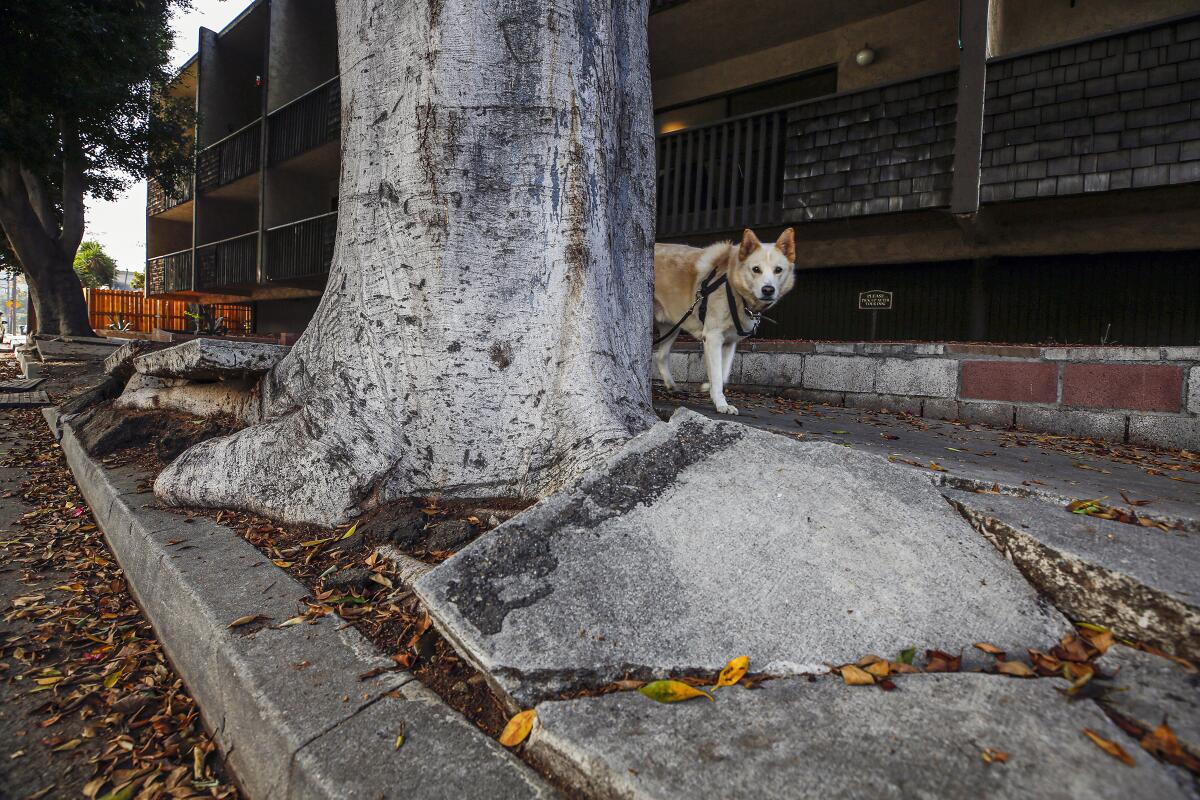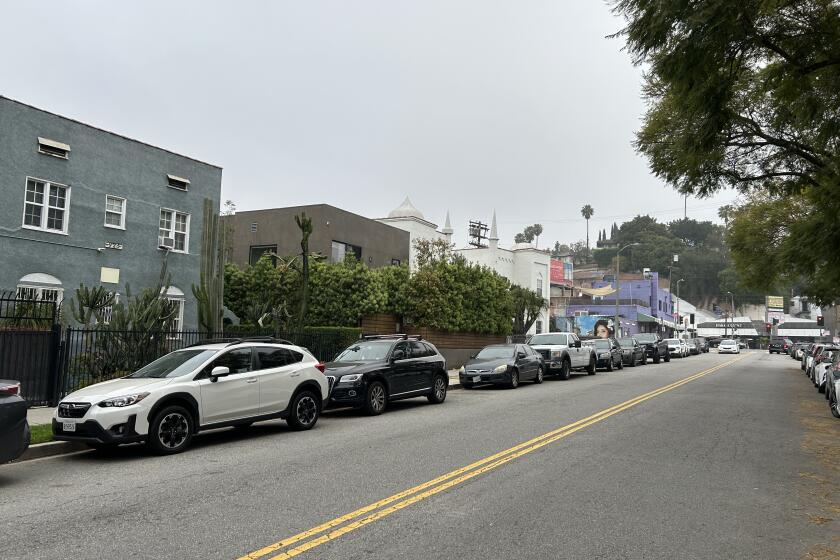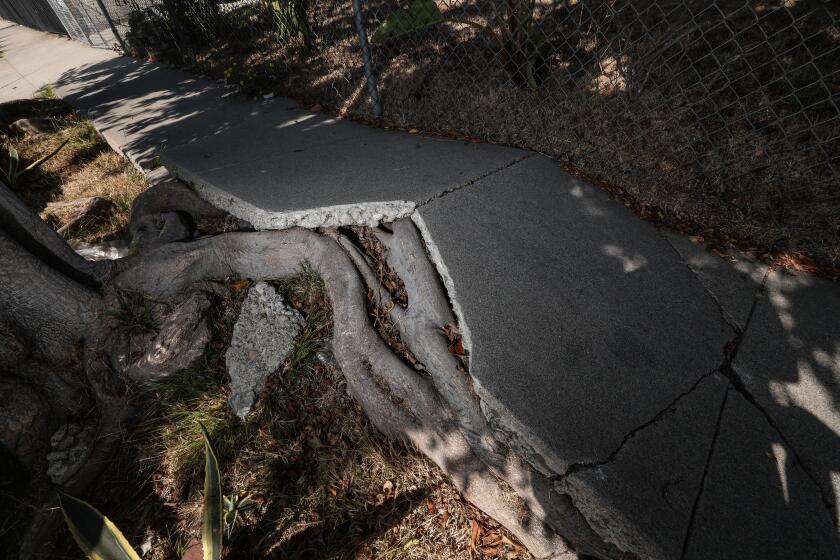Editorial: How L.A. squanders millions that could be spent fixing its streets and sidewalks

- Share via
In November 2020, Ismael Soto Luna, 59, was waiting to cross a street in Van Nuys when a 2-pound metal cap fell from a nearby streetlight and hit him on the head, knocking him to the ground and fracturing his skull.
He was later diagnosed with brain trauma and, as his condition worsened over time, dementia requiring 24-hour care, according to a lawsuit filed against the city. Earlier this year, the city of Los Angeles agreed to pay $21 million to settle Luna’s case.
During the trial, a liability expert retained by Luna’s attorney, Arash Zabetian, said he had reviewed thousands of city documents and found no standards for inspecting the lights on a regular basis. Even after Luna was injured, the city didn’t address the hazard, Zabetian said. Within a few blocks of the corner where the plaintiff was hurt, about half the light poles had caps that were loose or missing, meaning they had already fallen off.
The budget crisis shows Los Angeles is not living within its means. L.A. leaders approve employee raises the city can’t afford and then cut staffing and services while hoping for an economic boom to lift tax revenue.
Los Angeles is going broke, and liability payouts for such dangerous conditions are one reason. In just the first three months of the fiscal year, the city is on the hook for more than $47 million to resolve lawsuits and claims for injuries and other incidents on public property. The money is owed to people who tripped on broken sidewalks or crashed their bikes on crumbling asphalt, had property damaged by potholes or falling tree branches, and suffered other mishaps involving city infrastructure.
Of course, no city can completely prevent tree branches from falling on cars or immediately fix every pothole. But Los Angeles’ staggering backlog of basic maintenance is hurting residents and driving up liability costs. It typically takes more than a decade to get a sidewalk repaired. Street trees are pruned only about every 15 years. Half the city’s streets need to be resurfaced, and about 15% are considered failed.
The city is also far behind on basic maintenance of streetlights like the one that injured Luna. Bureau of Street Lighting General Manager Miguel Sangalang said the goal is to inspect lights once every 10 years. The city does respond to reports of burned-out lights, but it can take six months or longer to get one fixed.
Advocates are rightly pushing L.A. leaders to allow affordable apartments and townhomes on single-family-zoned properties near transit and major corridors in affluent areas.
Because of skyrocketing liability payouts, which also stem from cases involving employment matters and police use of force and negligence, the city is considering borrowing $80 million to pay off some judgments and settlements. That would cost an additional $20 million in interest at current rates, which means the city would be paying a total of $100 million just to resolve legal cases rather than to address any underlying issues.
“We are being asked to borrow money to cover the liability costs created by our crumbling infrastructure instead of actually fixing it,” lamented Jessica Meaney, executive director of the nonprofit Investing in Place.
This isn’t a new problem. For years, the city hasn’t budgeted enough money to adequately maintain streets, lights, sidewalks, trees and public infrastructure. It often takes a lawsuit and a ballot measure to force city leaders to prioritize safety and repairs. Indeed, in 2015, L.A. agreed to spend $30 million a year to fix broken sidewalks only after disabled residents sued the city.
That barely made a dent in the backlog, however. An audit found that in fiscal year 2020, the city spent $12 million — nearly half its total budget for sidewalk repairs — to resolve injury claims and lawsuits.
There’s a way to make the city more accessible, walkable and beautiful for the 2028 Olympics.
Meaney and other advocates have pushed L.A. to adopt a capital infrastructure plan, a multiyear, budgeted road map for investing in and maintaining public assets. Los Angeles is the only major city in the country without one, which forces its public works departments to beg and scramble for funding every year.
The Bureau of Street Lighting is an example. The agency does not have the staff or budget to regularly inspect streetlights to identify dangerously loose caps or other problems, or to swiftly fix burned-out or vandalized lights. The agency gets the bulk of its funding from taxes paid by property owners in street lighting assessment districts, but 90% of the assessments haven’t increased since 1996. Somehow the agency is expected to manage 220,000 streetlights with a funding stream that hasn’t changed in nearly 30 years, plus whatever the City Council and mayor can afford to spare each budget cycle.
L.A. cannot keep budgeting this way. The city is long overdue for a comprehensive plan that outlines infrastructure needs and costs, including for regular maintenance and improvements to public works, such as bus shelters, landscaped medians and protected bike lanes. Then the City Council and mayor can prioritize projects and commit spending — or seek more money through bonds or tax measures — to deliver on what Angelenos should expect from a world-class city.
Last month, Mayor Karen Bass announced that city staff would develop a multiyear investment plan to coordinate maintenance and improvements. Her Executive Directive 9 creates a Capital Planning Steering Committee to help deliver infrastructure projects in less time and at lower cost.
It’s a good idea, but the planning and prioritizing can’t be done behind closed doors. Bass and the City Council have to do this work in the open so that the public, including neighborhood councils, advocates and business leaders, knows what to expect and can hold city leaders accountable.
Los Angeles has underinvested in its infrastructure for decades. Residents are paying the price in higher liability payouts and embarrassingly decrepit streets, sidewalks and other public works.
More to Read
A cure for the common opinion
Get thought-provoking perspectives with our weekly newsletter.
You may occasionally receive promotional content from the Los Angeles Times.













